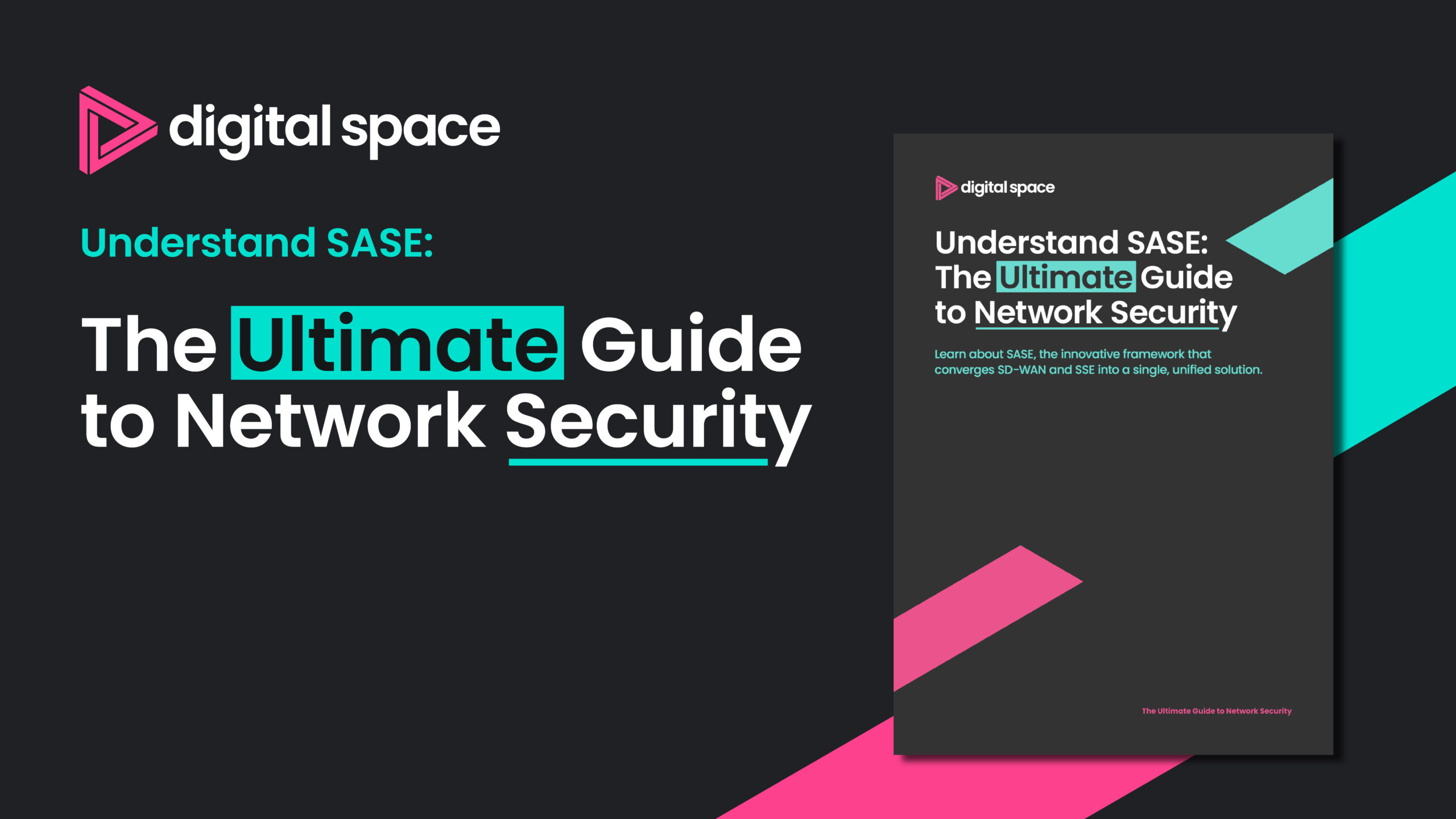Introduction
As businesses shift to cloud-first and remote work environments, Secure Access Service Edge (SASE) is emerging as the leading solution for modern network security. This article explores what SASE is, how it enhances security, and why it outperforms traditional models.
We’ll break down the key components of SASE, its security advantages, and how it works. You’ll also discover how to choose the right SASE provider, what to consider when adopting SASE, and use cases for it within a business like yours. By the end, you’ll have a clear roadmap to leverage SASE for a more secure, scalable, and efficient network.
What is SASE?
SASE can seem like a complex solution, so we’re comparing it to a game of Snakes and Ladders. Watch the video here.
Definition
SASE, or Secure Access Service Edge, is the convergence of 5 Connectivity and network Security technologies that work seamlessly together to secure users and devices from internet-based threats and cloud-based threats.
As employees’ workspaces remain equally as likely to be a dining table as they are a meeting room, securing users and devices regardless of location is crucial as the rate of Cyber threats still grows exponentially year on year.

How SASE Works
SASE combines networking and security services into a single, cloud-native framework to provide secure, high-performance access to applications and data from any location.
Traditional network security models rely on on-premises hardware and data centres and are no longer sufficient to handle the complexities of a distributed workforce, cloud adoption, and increasingly sophisticated cyber threats.
- Integration of SD-WAN and security services
- Cloud-native architecture and its benefits
By combining networking and security into one unified, cloud-native service, SASE provides secure, efficient access to applications and data, no matter where users are located.
Components of SASE

SASE isn’t its own technology but a collection of market-leading solutions that converge to create a single, coherent network security solution that’s pulled together using a management platform.
These are the technologies behind SASE that are managed within the platform:
Cloud Access Security Broker (CASB)
Cloud Access Security Brokers (CASBs) are a layer of security that sits between a business’s users and their cloud applications to provide enhanced visibility and control over data and traffic.
CASBs work by monitoring user activity across cloud services, applying security policies, preventing data loss, and ensuring compliance with regulations. CASBs secure sensitive data by enforcing encryption and data loss prevention (DLP) policies, blocking unauthorised access, and detecting threats like malware or abnormal user behaviour.
CASB integrates with identity solutions to enforce multi-factor authentication (MFA) and single sign-on (SSO), ensuring secure access for authorised users.
Firewall as a Service (FWaaS)
FWaaS is a cloud-based, next-generation firewall intrusion prevention system that provides security measures to protect users from malicious network traffic.
Networks are becoming increasingly distributed, and traditional firewalls are becoming less and less effective at being able to secure the entire network. Where traditional Firewalls and FWaaS differ is
Zero Trust Network Access (ZTNA)
Zero Trust Network Access (ZTNA) is a security framework that ensures secure access to applications and data by continuously verifying users and devices, applying least privilege principles, and monitoring for threats.
ZTNA provides secure, conditional access to applications by verifying the identity and device of every user before allowing them to connect, regardless of location. Unlike traditional VPNs, ZTNA assumes no user or device is trusted by default, continually authenticating and authorizing each session to minimize risk.
Secure Web Gateway (SWG)
SWG protects users from web-based threats by enforcing security policies and filters to internet-based traffic. It acts as a defence between users and the internet, inspecting and controlling employee access to websites, URLs, and web applications. Once a threat is identified, SWG then blocks access from the user, preventing the download of malware, and filters content based on pre-defined corporate policies, protecting users from attacks like phishing and ransomware.
Did you know that 90% of data breaches are caused by phishing attacks?
Software Defined Wide Area Network (SD-WAN)
SD-WAN (Software-Defined Wide Area Network) is a cloud-based architecture that simplifies and optimises the management of wide area networks. It uses software to intelligently direct traffic over the best available connections, improving performance and security and reducing costs while offering centralised control and visibility.
The primary benefits of SASE
Security, Cost, Simplicity
Amongst many other benefits, SASE enhances security by integrating Zero Trust principles, end-to-end encryption, and centralised policy enforcement to protect users, devices, and data across all locations. Combining SWG, CASB, FWaaS, and intrusion prevention into a single cloud-native solution it eliminates security gaps, reduces complexity, and provides real-time threat protection at scale.
SASE reduces costs by consolidating networking and security services into a single cloud-native platform, eliminating the need for multiple standalone solutions and expensive hardware. By leveraging a scalable, pay-as-you-grow model, it lowers operational expenses, simplifies management, and optimises network performance without costly infrastructure investments.
SASE simplifies network security by unifying networking and security functions into a single cloud-native solution, reducing the need for multiple vendors and complex integrations. With centralised management and automated policy enforcement, it streamlines operations, enhances visibility, and ensures consistent security across all users and locations.
SASE vs. Other Solutions
Alternatives to SASE typically involve using separate, traditional networking and security solutions rather than an integrated cloud-native approach. Some common alternatives include:
- Traditional MPLS with On-Prem Security – Using MPLS for secure connectivity and separate on-premises firewalls, VPNs, and SWGs for security. This offers stability but lacks scalability and flexibility.
- SD-WAN with Separate Security Services – Deploying SD-WAN for network optimisation while integrating standalone security tools like CASB, FWaaS, and SWG separately. This can be complex and harder to manage.
- VPNs for Remote Access – Relying on traditional VPNs to secure remote worker connections instead of Zero Trust Network Access (ZTNA), which can create security gaps and performance bottlenecks.
- Standalone Cloud Security Solutions – Using individual cloud security services (e.g., CASB, SWG, FWaaS) without a unified SASE framework, leading to siloed security policies and increased management overhead.
- DIY Hybrid Approach – Combining multiple point solutions from different vendors, such as SD-WAN, firewalls, and cloud security tools, to create a custom security stack, which can be complex, costly, and difficult to scale.
While these alternatives provide security and networking capabilities, they often lack the seamless integration, scalability, and efficiency of a fully converged SASE solution.
Use Cases for SASE
Securing Remote Workers
SASE secures remote workers by integrating multiple security functions into a single platform. It continuously verifies the identity and device health of remote users before granting them access to applications. Data encryption and advanced threat protection protect against web-based threats. Additionally, SD-WAN optimises network traffic for secure and high-performance access to cloud applications based on real-time conditions, regardless of the user’s location, ensuring that remote workers can work efficiently and securely.
Cloud Application Access Control
SASE enables secure access to cloud applications by using CASB to provide visibility into usage and enforce security policies. It ensures that sensitive data is protected while in use and prevents the use of unapproved cloud applications (shadow IT). SASE enables businesses to monitor and control which applications remote workers can access.
Branch Office Connectivity
SASE enhances the security and performance of branch office connectivity by integrating SD-WAN and Firewall-as-a-Service (FWaaS). This solution eliminates the need for costly MPLS circuits, optimising traffic routes to ensure faster, more reliable connections between branch offices and headquarters or cloud applications. It also provides centralised management of security policies, ensuring consistent protection across the organisation.
Protecting Employees from Internet-Based Threats ( Full Story)
How to Choose the Best SASE Provider
Selecting the right Secure Access Service Edge (SASE) provider is crucial for ensuring a secure, high-performance, and scalable network infrastructure. With a variety of vendors offering different capabilities, businesses should evaluate providers based on their ability to integrate security and networking while maintaining simplicity and cost-effectiveness.
Here are the key considerations to guide your decision:
1. Centralised Approach for Unified Management
A strong SASE provider offers a centralised approach, combining networking and security into a single platform. This ensures consistent policy enforcement across all locations and users while reducing the complexity of managing separate security solutions.
2. Cloud-Native Design for Scalability and Flexibility
To support modern workforces, a cloud-native design is essential. This allows the SASE solution to scale dynamically, adapting to fluctuating workloads and new security threats without requiring extensive hardware investments.
3. Global SLA-Backed Private Backbone for Performance and Reliability
A provider with a global SLA-backed private backbone ensures secure and optimised connectivity across geographically dispersed locations. This guarantees global network performance, minimising latency and improving the end-user experience.
4. Integration of Network and Security Services
A high-quality SASE provider should deliver seamless integration of network and security, including SD-WAN, Secure Web Gateway (SWG), Cloud Access Security Broker (CASB), Firewall as a Service (FWaaS), and Zero Trust Network Access (ZTNA). This eliminates security gaps and streamlines operations.
5. Compatibility with Legacy Systems
Many businesses still rely on legacy systems, so a SASE provider should offer smooth migration paths. The ability to integrate with existing third-party software ensures business continuity without costly overhauls.
6. Multitenancy Capabilities for Enterprise Needs
For organisations managing multiple departments or clients, multitenancy capabilities allow for efficient resource sharing while maintaining isolated security policies and network configurations per tenant.
7. Role-Based Access for Granular Control
Strong role-based access controls ensure that users and administrators only have the necessary permissions, reducing security risks and aligning with Zero Trust principles.
A well-defined service level agreement (SLA) sets clear expectations for uptime, response times, and support, ensuring that the provider meets business-critical performance requirements.
By evaluating these factors, organisations can select a SASE provider that meets their security, performance, and scalability needs while optimising costs and simplifying network management.










